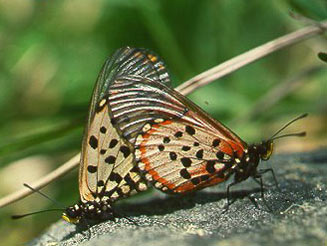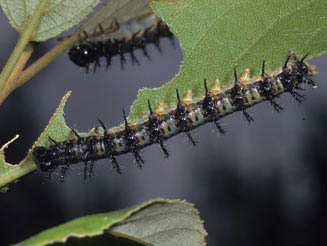|
Acraea horta (Garden acraea butterfly)
Life
> Eukaryotes >
Opisthokonta >
Metazoa (animals) > Bilateria > Ecdysozoa >
Panarthropoda > Tritocerebra > Phylum:
Arthopoda > Mandibulata >
Atelocerata > Panhexapoda >
Hexapoda
> Insecta (insects) > Dicondyla > Pterygota >
Metapterygota > Neoptera > Eumetabola > Holometabola > Panorpida >
Amphiesmenoptera > Lepidoptera (moths
and butterflies) > Glossata > Coelolepida > Myoglossata > Neolepidoptera >
Heteroneura > Ditrysia >
Apoditrysia > Obtectomera >
Macrolepidoptera >
Rhopalocera
(butterflies) > Papilionoidea > Family:
Nymphalidae > Subfamily:
Heliconiinae > Tribe: Acraeini > Genus: Acraea
 |
 |
|
Adult male, Linwood. [photo
Steve Woodhall ©] |
Adults mating:
the female (left) is paler and browner than the more
reddish-patterned male (photo. N. Larsen) |
 |
 |
|
Larva (host plant is Wild peach ). In summer the
larvae take 4-5 weeks to develop, passing through 6 instars, whereas in
winter development is arrested by the cold temperatures so the larval
period is considerably longer. |
Pupa. Mature larvae can walk a long distance to
find a suitable pupation site which is usually against a wall or rock.
To pupate, the larva spins a silken pad to which the pupa is attached. |
The Garden acraea is one of the commonest butterflies in
Cape Town gardens but can be found in woodlands and gardens throughout the
moister regions of South Africa, and is also known from Zimbabwe (and
Mozambique?). Picker and
Griffiths (1989) deal thoroughly with the parasitic wasps and flies that
attack the different life stages.
Balinsky (1974, 1977, 1979, 1981, 1986) studied variation and
heritability in this species; his findings are summarised by Fabian (2009). Breeding
- Eggs
are laid in clusters of about 40 (about 150 maximum per cluster) on leaves
of the host plant - either Wild Peach Kiggelaria
africana or a species in the Passifloraceae. They take about nine days
to hatch. The young larvae are gregarious (i.e. they keep together)
but as development proceeds, they spread out.
Host plants
References
-
Balinsky, B.I. 1974. Ten generations inbreeding of Acraea
horta (L.) (Lepidoptera). Journal of the Entomological Society of
Southern Africa 37: 9-86.
-
Balinsky, B.I. 1977. Inheritanceof wing colour in females of
the butterfly Acraea horta. Journal of the Entomological Society of
Southern Africa 40: 1-11.
-
Balinsky, B.I. 1979. Variation and inheritance of wing
spotting in the butterfly Acraea horta (L.). Rev. Zool. Afr.
93: 810-879.
-
Balinsky, B.I. 1981. Immediate and delated effects of
radiation on the genetic endowment of the butterfly, Acraea horta L.
South African Journal of Science 77: 162-167.
-
Balinsky, B.I. 1986. Early differentiation in the egg of the
butterfly, Acraea horta under normal conditions and after ultraviolet
irradiation. Acta Embryol. Morph. Exp. 6: 103-141.
-
Claassens, A.J.M. & Dickson, C.G.C. 1980. The
Butterflies of the Table Mountain Range. C. Struik Publishers, Cape Town.
-
Fabian, B. 2009. Balinsky's Darwinian roots. South
African Journal of Science 105: 410-414.
-
Picker,
M. & Griffiths, C. 1989. Insects within insects. Sagittarius
4(1): 12-15.
Text by Hamish G. Robertson |
